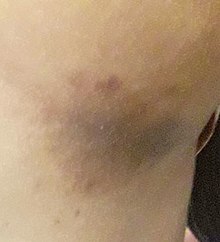Erythrasma
| Classification according to ICD-10 | |
|---|---|
| L08.1 | Erythrasma |
| ICD-10 online (WHO version 2019) | |
The Erythrasma (also Zwergflechte or Baerensprungsche disease ) is a common, usually harmless disease of the skin caused by bacteria of the type Corynebacterium minutissimum is caused.
Predisposing factors are excessive perspiration or local hyperhidrosis , obesity , diabetes mellitus or immunosuppression (e.g. in the context of HIV ).
Preferred localizations ( predilection points ) are primarily intertriginous areas such as armpits, groins and other large skin folds ( inguinal , axillary , perianal , submammary ), as well as between the toes, as this is where sweating increases and the acid balance of the skin is disturbed.
It can be recognized by a large, well-defined reddening of the skin . Later on, the color usually changes to brownish (coffee with milk) and the skin shows fine, scaly wrinkles. Usually there is no itchiness .
Erythrasma is diagnosed on the basis of the clinical picture or with the help of the UV light of a Wood lamp , whereby it glows coral red due to the porphyrin production of the pathogen.
Therapy for erythrasm consists of strict hygiene, the use of acid soaps to stabilize the skin environment and the local application of ointments containing imidazole or fusidic acid . In severe cases, the systemic use of erythromycin or clarithromycin as well as penicillin V is possible. In general, the affected areas of skin should be kept dry (dry them thoroughly; for larger skin folds, the use of gauze compresses can be helpful).
The differential diagnosis a Candida - intertrigo or inverse psoriasis to think.
literature
- ML O'Dell: Skin and wound infections: an overview. In: Am Fam Physician. 1998 May 15; 57 (10), pp. 2424-2432. Review. PMID 9614412
Individual evidence
- ↑ Other bacteria - Erythrasma. In: Otto Braun-Falco, Helmut Heinrich Wolff: Dermatology and Venereology. Springer, 2005, ISBN 3-540-40525-9 , p. 115. (at Google books)
- ^ Marianne Abele-Horn: Antimicrobial Therapy. Decision support for the treatment and prophylaxis of infectious diseases. With the collaboration of Werner Heinz, Hartwig Klinker, Johann Schurz and August Stich, 2nd, revised and expanded edition. Peter Wiehl, Marburg 2009, ISBN 978-3-927219-14-4 , p. 159.
